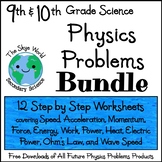Work and Power Problems Worksheet
- PDF
What educators are saying
Also included in
- This bundle of worksheets will prepare students to solve simple physics problems including speed, acceleration, momentum, force, energy, work, power, power, heat, electric power, Ohm's law, and wave speed. By completing these activities, 9th and 10th grade science and conceptual physics science stPrice $24.00Original Price $36.00Save $12.00
- This bundle of lessons covers work problems, power problems, mechanical advantage, simple machines, classifying levers, and more! These activities will help your 9th and 10th grade physical science students learn to solve problems step by step for accuracy. Hands on lab activities make physics fun aPrice $22.00Original Price $33.00Save $11.00
- This mini-bundle of lessons will prepare your 9th grade physical science students to calculate work and power problems. Students will learn how to classify simple machines into 6 groups as well as identify 3 classes of levers by their fulcrum position and mechanical advantage. Important InformationAPrice $6.00Original Price $9.00Save $3.00
- This growing bundle covering a year of curriculum for 9th and 10th grade physical science (integrated physics and chemistry) includes the bundles of activities listed below. All lessons are aligned to the TEKS (Texas Knowledge and Skills). Bundles include notes, worksheets, card sorts, task cards,Price $274.00Original Price $420.00Save $146.00
Description
By completing this activity, 9th and 10th grade physical science students will learn how to calculate work and power problems. Students will solve problems using the variables force, time, distance, and power. Metric units are used in every problem including Newtons, seconds, kilometers, and Watts. Teach students to show their work step by step with columns for formula, work, and answer with units.
Important information
- Answer keys always included
- No need for calculators; perfect way to review basic math skills
- Recommended for 9th and 10th grade science, Physical Science, IPC (Texas), and algebra-based Conceptual Physics
TEKS Covered
I.4C - investigate how an object's motion changes only when force is applied
NGSS Standards Covered
HS.PS2-1 - force, mass, and acceleration
Also found in these money saving bundles
- Bundle of Lessons - Work, Power, and Simple Machines
- 9th and 10th Grade Physical Science Bundle of Lessons - includes 13 Bundles
- Bundle - Physics Problems Worksheets
Related Resources
- Lab Activity – Calculating Stair Climbing Power
- Lab Activity - Three Classes of Levers
- Card Sort Activity – Simple Machines
Acknowledgements
- Thank you to Ron Leishman Digital Toonage for the commercial right to use his clipart. Click here to visit his creative TpT site.
- Thank you to Sarah Pecorino Illustration for the commercial right to use her clipart. Click here to visit her wonderful TpT site.
Terms of Use – copyright ©Catherine Skye All rights to this product are reserved by author. This authorizes one teacher to use this product. If you want to share it with other teachers, please purchase a license to share this work. Copying by more than one teacher, classroom, department, school, or school system is prohibited UNLESS you purchase a license. Clipart and elements found in this PDF and others on my site are from the public domain unless otherwise noted. All products on my site are intended for classroom and personal use and may not be digitally copied for reuse in any form. Any misuse is considered copyright infringement and violates the DMCA (Digital Millennium Copyright Act).









